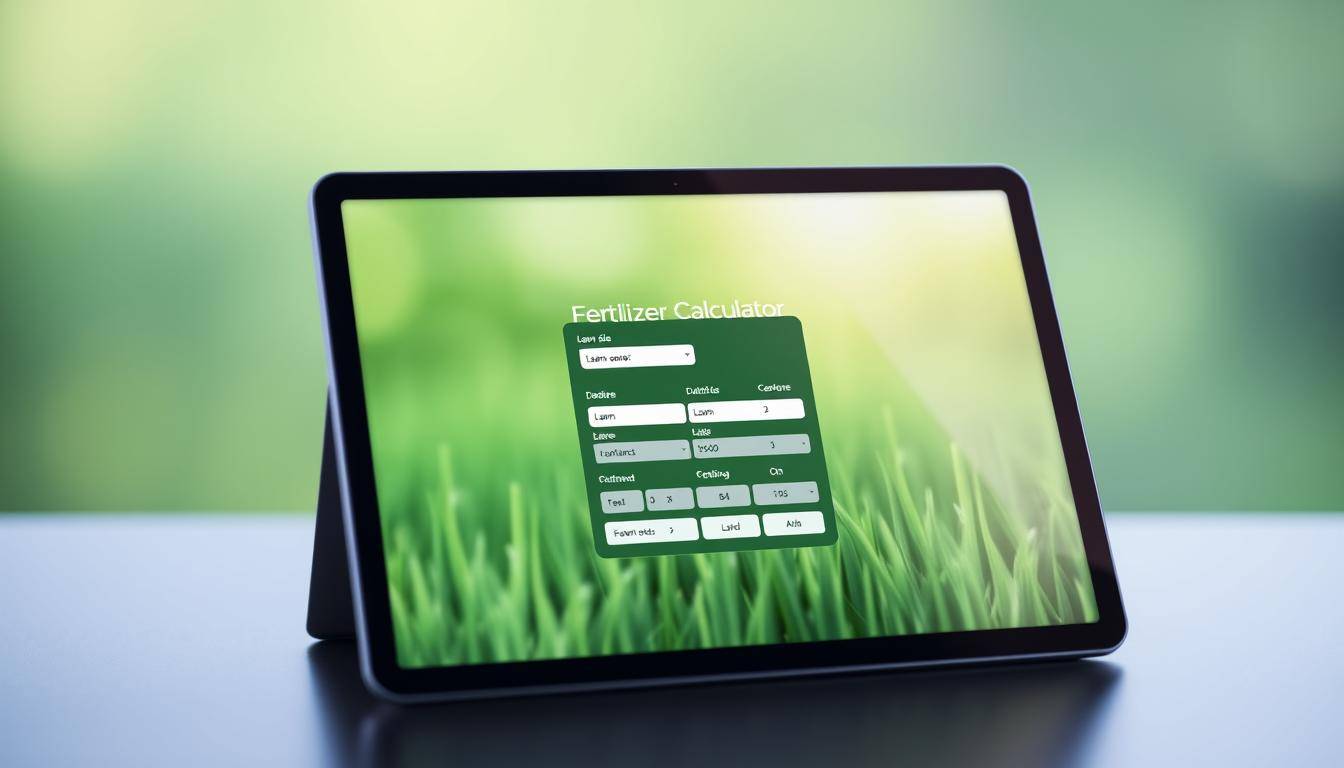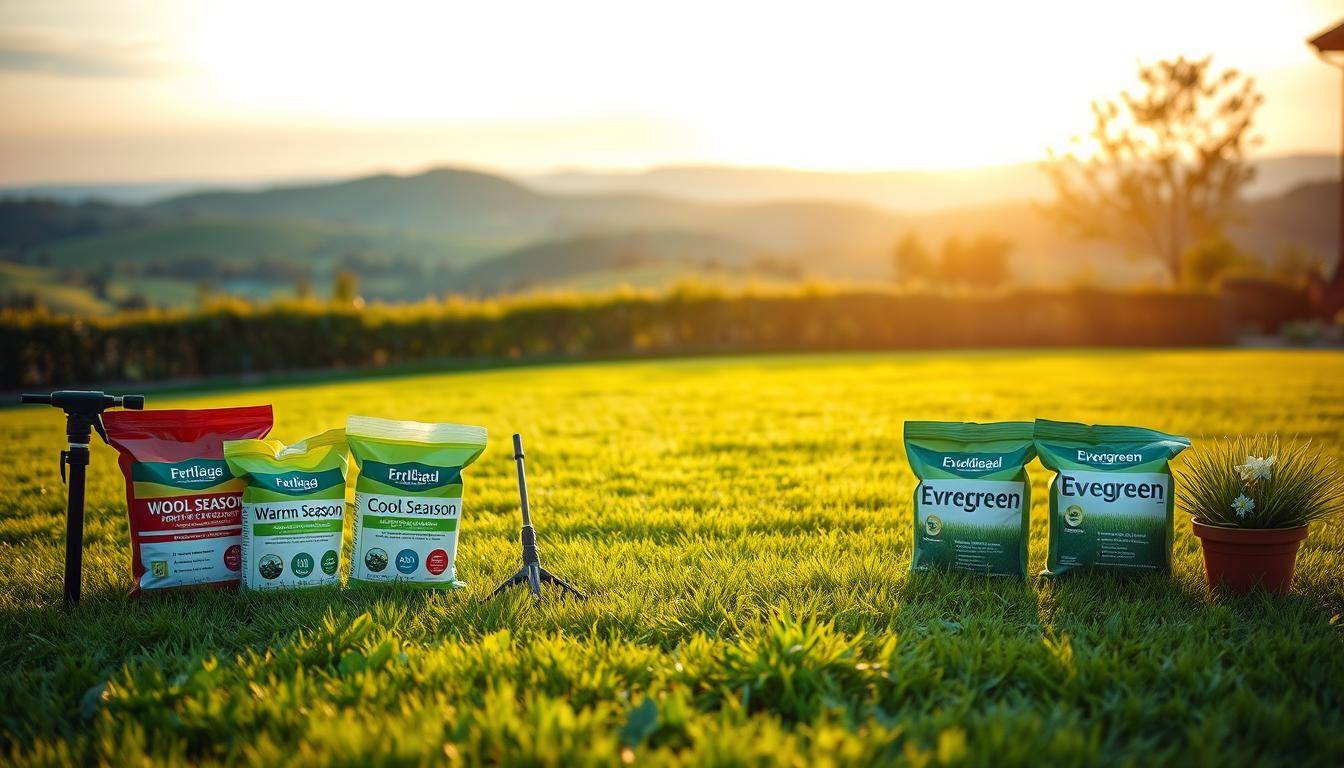Fertilizer Calculator: Find the Right Amount for Your Lawn
Surprising fact: nearly half of homeowners apply more lawn nutrients than their grass needs, wasting money and harming local waterways.

We built this tool to make the process simple. We show how to translate a desired nitrogen target into the exact amount to spread. Our approach saves time and reduces guesswork.
Before you start, gather your lawn area in feet, your grass type, and the N‑P‑K numbers on the bag. Then we use a clear way formula that divides the target nitrogen rate by the percent N on the label to get the fertilizer rate.
We align recommendations to seasonal and annual rates for cool‑ and warm‑season turf. We also stress soil testing and local extension guidance so your results match science‑based guidelines.
Key Takeaways
- Our tool converts a nitrogen target into the precise weight and number of bags to buy.
- You need lawn area, grass type, and the product analysis to get accurate results.
- We follow monthly and yearly rate guidelines to avoid overapplication.
- Soil tests and local advice refine targets and protect waterways.
- Clear, step‑by‑step examples show how we determine much material to use.
What Our Fertilizer Calculator Does and Why It Matters
Our tool turns your turf goals into clear, usable application rates so you buy and spread only what the lawn needs. We accept targets per 1,000 sq ft or per acre and use the N‑P‑K percent on product labels to convert a desired nitrogen rate into the exact weight in pounds fertilizer to apply.
Labels show percent by weight of nitrogen, phosphate (P2O5), and potash (K2O). That simple translation prevents over-application of fertilizers and gives reliable amounts and optional bag counts for ordering.
We integrate soil and soil test guidance so recommendations match local conditions. A soil test lets you check nutrient levels and pH (ideal near 6.5–7.0 for many grasses), which refines the amount and timing of application.
- We convert your target nitrogen into fertilizer weight using the label percent of N and seasonal rates.
- Correct amounts support plant health and turf density while reducing runoff risks.
- We base our recommendations on extension guidelines and evidence-based practices to keep yearly and monthly rates within safe limits.
In short: this approach gives better information, clearer recommendations, and predictable results—so you apply the right amount at the right time without wasting product or harming nearby waterways.
How to Use the Fertilizer Calculator Step by Step
Start by measuring your lawn so every number uses the same units. Use a tape measure or online mapping tool to get square feet or acres. Consistent units keep our calculations accurate and repeatable.

Measure the area
Record total square feet or acres. If you have acres, convert to 1,000‑sq‑ft units for easy comparison.
Set your target nitrogen rate
Choose the desired N per 1,000 sq ft (or per acre) based on grass type and season.
Enter N‑P‑K analysis numbers
Find the three numbers on the bag; these are percent by weight. Enter the percent N as a number, not a decimal.
Apply the core formula
Formula: fertilizer application rate = desired N ÷ (percent N / 100).
Convert to pounds and bags
Multiply the per‑unit product pounds by your area then divide by bag weight to get the number of bags.
Worked example
For a 1 lb N/1,000 sq ft target using 25‑5‑10: desired N = 1 lb; percent N = 25.
| Step | Value | Result |
|---|---|---|
| Formula | 1 ÷ (25/100) | 4.0 pounds product per 1,000 sq ft |
| Acre conversion | 4.0 × 43.56 | 174.24 pounds product per acre |
| Bag planning | Bag weight example: 50 lb | 174.24 ÷ 50 = 3.49 bags → round up to 4 bags |
In short: precise area, correct analysis numbers, and consistent units let us determine much product you need. Our process makes the calculations transparent and ordering simple.
Seasonal Application Rates and Timing by Grass Type
Knowing when to apply nutrients is as important as knowing how much to spread. Proper timing helps turf use what we apply and reduces runoff. Below we give clear seasonal windows and annual targets for common grasses.

Cool‑season lawns
For tall fescue, perennial ryegrass, and Kentucky bluegrass, focus most nitrogen in fall. Apply up to 0.9 lb N/1,000 sq ft from September to November. Keep spring applications minimal to avoid stress during summer heat.
Warm‑season lawns
Bermudagrass, St. Augustine, zoysia, and centipede use nutrients best in late spring and summer. Plan applications up to 1.0 lb N/1,000 sq ft per event when growth is active.
Annual targets and practical notes
- Cool‑season: 2–3.5 lb N per 1,000 sq ft per year; warm‑season: 2–4 lb per year.
- Fine fescues, zoysia, and centipede often need only 1–2 lb per year.
- Overseeding note: in winter overseeded Bermudagrass, a fall dose of 0.5–0.9 lb may aid establishment.
We recommend a quick soil test and local extension recommendations when unsure. Keep simple records of dates, pounds nitrogen, and feet treated so you can track your year plan and avoid applying much nitrogen at once.
“Seasonal pacing prevents excess growth and protects local waterways.”
Soil Tests and Adjustments that Refine Your Application Rate
A current soil test gives us the facts needed to set an accurate plan for your lawn. It reports nutrient levels and pH so we can tailor the amount and timing of inputs.
Why test? A test shows if pH sits near the ideal 6.5–7.0 and whether phosphorus or potassium are low. That information prevents waste and saves money by avoiding unneeded products.
Organic matter, climate, and timing
Soil organic matter matters. If SOM >3% we typically reduce nitrogen by ~15–20 lb per acre. If SOM
Legume credits and stubble effects
Legumes can give a credit (alfalfa ≈ 40 lb N per acre), lowering how much we add. Conversely, heavy stubble can immobilize N — estimate ~10 lb N per 1,000 lb stubble (capped near 40 lb per acre) and adjust upward briefly.
Phosphorus and potassium strategies
We use three approaches: sufficiency (address immediate shortfalls), maintenance (replace what turf removes), and build (raise soil test levels over seasons). Match your product percent and analysis to these goals.
- Pair a current soil test with our recommendations to set a realistic nitrogen target.
- Re‑test periodically to track progress and refine guidelines.
- Keep records of pounds applied and test results so future decisions need less guesswork.
“Accurate testing reduces inputs and improves turf response.”
Choosing the Right Fertilizer: N-P-K, Slow-Release, and Labels
Choosing the right product analysis and nitrogen source makes every application more efficient and predictable.
Start by reading the guaranteed analysis. The three numbers show percent by weight of N, P2O5, and K2O. For example, 28‑0‑6 has 28% nitrogen.
We favor slow‑release nitrogen when steady feeding and lower loss risk matter. Slow‑release options include polymer‑coated urea and sulfur‑coated urea. Fast‑release gives quick green‑up but raises burn and leaching risk.
Match product to climate and timing
In cold winter soils, organic sources may release N slowly because microbes are inactive. In warmer climates, blended products with fast and slow fractions balance color and longevity.
- Read labels to spot slow‑release sources in the guaranteed analysis.
- Higher‑N analyses reduce pounds of product needed to hit a target.
- Choose a product that fits soil test goals for phosphorus and potassium.
Practical tip: store bags dry and sealed so quality stays intact across seasons. Smart label reading plus our tool ensures planned applications deliver the intended nutrients with fewer surprises.
“Know the analysis and pick the type that suits your climate and schedule.”
Responsible Applications: Preventing Leaching and Protecting Waterways
Protecting local waters starts with how we plan and time every application. Excess material can move off the lawn and fuel algal blooms in streams. That makes outdoor care a community concern.
Best practices to reduce runoff and nitrate leaching
Test first. A current soil test tells us what the lawn needs so we apply only the proper amount. Right‑sizing inputs cuts leaching risk and saves money.
Split seasonal totals into several smaller applications timed to active growth. This improves uptake and lowers the chance that nitrates wash away after heavy rain.
Calibrating spreaders, splitting applications, and sweeping hardscapes
- Calibrate spreaders to the chosen rate and check settings when moving across an acre or varied terrain.
- Sweep granules from driveways, sidewalks, and curbs so particles do not enter storm drains.
- Avoid applications just before heavy storms; water in lightly when labels recommend to move granules into the canopy and soil.
| Action | Why it helps | Practical note |
|---|---|---|
| Calibrate spreader | Ensures even distribution and correct application | Test on a 100 sq ft area before treating an acre |
| Split applications | Reduces leaching losses and increases uptake | Use 2–4 smaller events rather than one large dose per acre |
| Sweep hardscapes | Prevents granules from entering storm drains | Collect and return swept material to the lawn |
| Choose slow‑release sources | Moderates nutrient availability and reduces spikes | Look for labeled slow‑release fractions on the bag |
We follow extension recommendations and local guidelines when available. Regular testing, careful equipment checks, and steady pacing protect plants, property, and water. Responsible care keeps nutrients where they belong—on the lawn, not in our streams.
“Good lawn care and good stewardship go hand in hand.”
Conclusion
,We close with a short action plan to turn an application rate into reliable results.
Measure the area, pick a target application rate, enter the bag analysis numbers, and run the calculations to get pounds per 1,000 sq ft or per acre and the number of bags to buy.
Space out pounds nitrogen across the year by following seasonal windows for your grass type so you avoid excess growth and extra mowing.
Use a current soil test to match phosphorus and potassium strategy to your soil levels. Track dates, numbers, and product type so future plans are easier to refine.
Calibrate spreaders, sweep hardscapes, and avoid applications right before heavy rain to protect water quality. Then put the plan into action: measure, set the rate, enter the analysis, and treat at the right time for the best results.
FAQ
What does the tool calculate and why is it useful?
We convert target nitrogen rates into the pounds of product you need, based on your lawn area and the product’s analysis (N‑P‑K). This saves time, reduces waste, and helps avoid overapplication that can harm turf and waterways.
How do we measure our lawn area correctly?
Measure length and width in feet for rectangular zones, or use a wheel or GPS app for irregular shapes. Convert square feet to acres by dividing by 43,560 when you prefer per‑acre rates.
What is the core formula we use to determine application rate?
We divide the desired pounds of nitrogen by the fraction of nitrogen in the product (desired N ÷ [percent N ÷ 100]). That yields pounds of product per area.
How do we convert results into total bags or pounds for the whole lawn?
Multiply pounds per 1,000 sq ft by your total area (in thousands of sq ft). Then divide total pounds needed by the bag weight to get the number of bags to buy.
Can you give a worked example using common numbers?
Yes. For 1 lb N per 1,000 sq ft using a 25‑5‑10 product: percent N = 25, so product needed = 1 ÷ 0.25 = 4 lb of product per 1,000 sq ft. For a 10,000 sq ft lawn, multiply 4 × 10 = 40 lb total.
How often should we apply nitrogen each year?
Frequency depends on grass type and goals. Cool‑season grasses typically receive multiple smaller applications in spring and fall; warm‑season grasses get most N in late spring through summer. Annual totals follow regional extension guidelines.
How does grass type affect rates and timing?
Cool‑season species (tall fescue, rye, Kentucky bluegrass) need most N in cooler months. Warm‑season species (Bermuda, zoysia, St. Augustine) take up N in warm months. We adjust timing and split applications to match active growth.
Why should we test soil before applying nutrients?
A soil test tells us nutrient levels, pH, and organic matter. That lets us target phosphorus and potassium, avoid unnecessary inputs, and fine‑tune nitrogen recommendations for cost‑effective care.
How do organic matter, climate, and timing change recommended rates?
High organic matter or cool, wet climates can increase nitrogen mineralization or leaching, so we may reduce or split rates. Hot, dry regions might need different timing to reduce stress and loss.
What are legume credits and stubble immobilization adjustments?
Legume credits reduce N needs when clover or other legumes fix nitrogen. Immobilization occurs when high carbon residues tie up N; we compensate by adjusting timing or adding starter N to ensure availability.
How should we manage phosphorus and potassium applications?
We follow soil test results: supply P and K to reach sufficiency, then maintain with lower rates. Avoid routine P application unless tests indicate a deficiency or new turf establishment.
How do we read N‑P‑K numbers and choose the right product?
N‑P‑K shows percent nitrogen, phosphorus (P2O5), and potassium (K2O). Choose a product that supplies the nutrients you need at the desired N rate; calculate product amount using the percent N.
What’s the difference between slow‑release and fast‑release nitrogen?
Fast‑release gives quick green‑up but raises leaching and burn risk. Slow‑release provides longer feeding, less leaching, and steadier growth. We select type based on climate, season, and management goals.
How can we prevent runoff and nitrate leaching?
Use split applications, apply at recommended rates, calibrate spreaders, avoid application before heavy rain, and sweep product off sidewalks to keep nutrients on turf and out of storm drains.
How do we calibrate a broadcast or drop spreader?
Follow the spreader manufacturer’s pattern test: measure area, run at normal walking speed, collect and weigh material applied, and adjust settings until pounds per 1,000 sq ft match the calculated rate.
Can we split applications during the season, and why?
Yes. Splitting reduces plant stress, lowers loss to leaching, and keeps turf healthier. We commonly divide the seasonal total into multiple smaller applications aligned with growth flushes.
How should we adjust applications in winter or dormancy periods?
Avoid applying significant nitrogen during dormancy unless using specific late‑fall programs recommended for that grass type. Excess N before freeze increases leaching and can encourage disease.
Where can we find region‑specific rates and extension recommendations?
State land‑grant university extension services (e.g., University of California, Penn State, University of Florida) publish local guidelines. We recommend following those for precise, climate‑based rates.
How do we account for multiple zones, slopes, and hardscapes in calculations?
Measure each zone separately, adjust rates on slopes to reduce runoff, and reduce product near sidewalks and driveways. Combine zone totals to plan purchases and applications.
What safety and storage practices should we follow?
Store products in a cool, dry place out of reach of children and pets. Use gloves and follow label directions for application, cleanup, and disposal to protect people and the environment.
For More Tools: Click Here